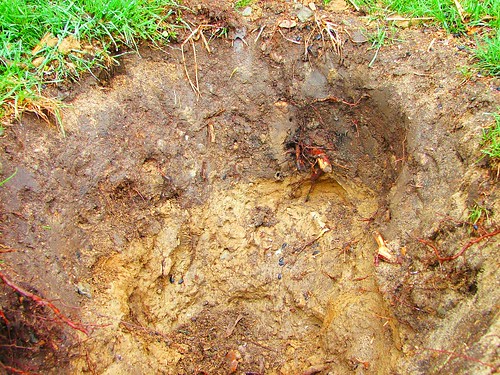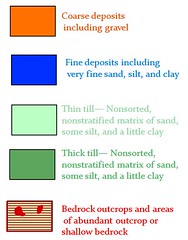 I didn't know clay soil was even in Massachusetts. But I live on it, and so I know it's here! This is what MY CLAY SOIL looks like today.
I didn't know clay soil was even in Massachusetts. But I live on it, and so I know it's here! This is what MY CLAY SOIL looks like today.It looked exactly the same six months ago when I first dug it up. It's WET. It's MOLDABLE. It's MUDDY. It's DIRTY. But mostly it is WET.
Evidently, clay soils can dry up and become as hard as cement in periods of drought. That can be REALLY BAD for grass and plants and flowers. I don't know if Framingham has ever had such a drought, or if it would affect my yard if it did happen. Given the nature of clay, it will take a long, long time for this saturated soil to dry up at all; never mind turning into cement. It could happen, of course. I just can't imagine it being anything but fully saturated around here. I mean, the trees are mossy!

What is clay soil? Well, clay particles are extremely small, with 1,000 times the surface area in a given volume of soil compared with larger sandy soil particles. As a result, clay packs closely and binds water tightly by surface tension preventing it draining away.
Clay particles, bound end to end and side to side in extensive planes, are stacked in a sandwich like matrix and held together by electrochemical forces. This platelike stacking of horizontally arranged clay particles results in a large surface area. When these horizontal aggregations are stacked high and consolidated over time, they can be quite tight and sticky. Clay can hold a lot of nutrients, and some kinds can hold quite a bit of water, but the structure of clay doesn't let air and water move through it well. Most of the water in a clay soil is so tightly bound to the clay particles that plants can't get it loose.
You can't garden very well in clay soil. All the gardens in this yard have plastic laid down and real good soil laid on on top.

All the good dirt is just about gone, now.
Clay can even act like QUICKSAND in some circumstances! My husband remembers going to the "clay flats" in Braintree, and jumping on the clay like a trampoline. Every ten years or so, someone would break through the clay and start to sink to their death! The firetrucks always rescued the victims in time, fortunately.
But there isn't any clay soil within miles of my neighborhood, according to the USGS Soil Survey:

According to the map legend, clay soil would be BLUE. Do you see any blue north of route 9?
I felt cheated to find clay after researching neighborhood soil, but I wasn't being reasonable. The government doesn't sample every inch of soil, and there are pockets of clay soils everywhere.
I had to contact an expert to find out why there are there are pockets of clay soil everywhere. I was lucky enough to find an expert in Professor Lawrence McKenna from Framingham State College. Professor McKenna didn't mind explaining the topic to someone as clueless as I am.
As I understand it, clay soil is a glacial phenomenon in Massachusetts, like virtually all the topography and geology of our state. In some cases, the retreating glaciers left behind small ponds of water not fed by streams or rivers. Over the centuries, the fine dust and light particles carried by the wind would get drawn to the water and trapped there. Layer upon layer of very small particles accumulated over time, and remained when the water was long gone. These layers of infinitesimally small molecules are now known as clay.
Clay is great for pottery and tiles and pipes, and has thousands of other beneficial uses. But clay soil is always a problem to build on. It is bad for gardening, bad for lawns, and very bad for foundations. Clay soil can crack a foundation right down the middle, or keep a foundation so wet that mold grows inside the walls and spreads everywhere. (It can be potentially dangerous if you jump on it, too!)
But that is not all that clay can do. Wait until you hear about how CREEPY clay soil can be!
Clay is great for pottery and tiles and pipes, and has thousands of other beneficial uses. But clay soil is always a problem to build on. It is bad for gardening, bad for lawns, and very bad for foundations. Clay soil can crack a foundation right down the middle, or keep a foundation so wet that mold grows inside the walls and spreads everywhere. (It can be potentially dangerous if you jump on it, too!)
But that is not all that clay can do. Wait until you hear about how CREEPY clay soil can be!



That is one awesome natural clay ball!
ReplyDeleteHi Susan,
ReplyDeleteMy husband and I, we recently bought a house in Worcester and we have a pretty big back yard where I wonder if I could find some clay as well and eventually build my dreamed brick/clay oven/stove. Did you have a guess that you could find it based on features around, such as soil, vegetation, water drainage, and so on? I was so excited when I found your post because it might be possible to find something around Worcester too. Thank you for posting it!